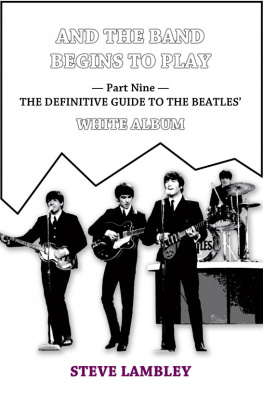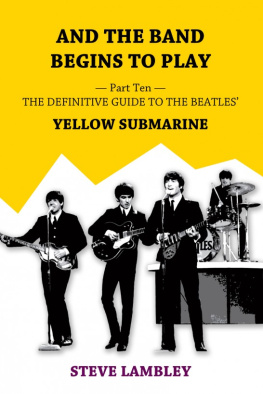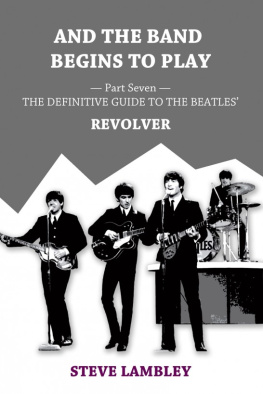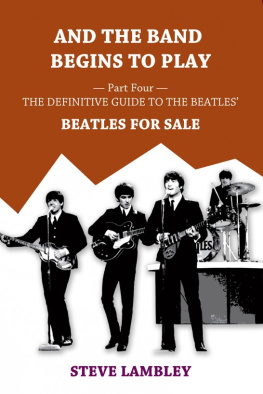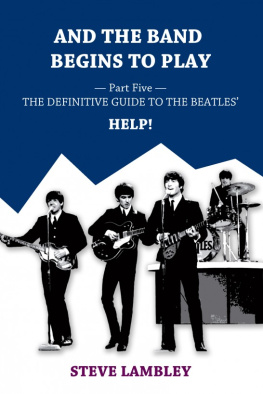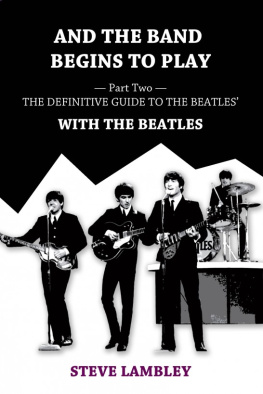AND THE BANDBEGINS TO PLAY
Part Three The Definitive Guide to the Beatles A HARD DAYSNIGHT
by
SteveLambley
Published bySLIDE Books
Version 2.0
Steve Lambley2014
All song lyricsremain the copyright of their respective owners, and are quoted forthe purposes of scholarship, under fair dealing and fair usagelaws. No infringement is intended.
No part of thisbook may be reproduced in any form without written permission fromthe copyright holder.
SmashwordsEdition, Licence Notes
This ebook islicensed for your personal enjoyment only. This ebook may not bere-sold or given away to other people. If you would like to sharethis book with another person, please purchase an additional copyfor each recipient. If youre reading this book and did notpurchase it, or it was not purchased for your use only, then pleasereturn to Smashwords.com and purchase your own copy. Thank you forrespecting the hard work of this author.
Table ofContents
Single release
Parlophone R 5114 Released 20 March 1964
Cant Buy Me Love
[Lennon-McCartney]
Recorded 29 January, 25 February, 10 March
Mixed 26 February (mono), 10 March (stereo)
Paul leadvocals, bass
John acoustic guitar
George lead guitar
Ringo drums
The AmericanBillboard Hot 100 listing for 4 April 1964 sums up thefrenzy generated when Beatlemania swept across the Atlantic. Itincludes no less than twelve Beatles songs, and features a trulyremarkable top five
1. Cant Buy MeLove The Beatles (Capitol)
2. Twist AndShout The Beatles (Tollie)
3. She LovesYou The Beatles (Swan)
4. I Want ToHold Your Hand The Beatles (Capitol)
5. PleasePlease Me The Beatles (Vee Jay)
31. I Saw HerStanding There The Beatles (Capitol)
41. From Me ToYou The Beatles (Vee Jay)
46. Do You WantTo Know A Secret The Beatles (Vee Jay)
58. All MyLoving The Beatles (Capitol/Canada)
65. You CantDo That The Beatles (Capitol)
68. Roll OverBeethoven The Beatles (Capitol/Canada)
79. Thank YouGirl The Beatles (Vee Jay)
The Beatlesmonopoly of the Billboard top five followed two weeks of thegroup occupying the top three spots, and one week of themcomprising the top four. The following week, on 11 April, TheresA Place and Love Me Do (both Tollie, a subsidiary of Vee Jay)also entered the chart, the latter getting to number one.
Under theAmerican system at that time, both sides of a single could chart,depending on the song requested at the point of sale. So, the abovetwelve songs were available on eight actual discs, the (US) Capitoland Vee Jay entries being double-sided hits Cant Buy MeLove/You Cant Do That, I Want To Hold Your Hand/I Saw HerStanding There, Please Please Me/From Me To You and Do YouWant To Know A Secret/Thank You Girl. Roll Over Beethovencharted because a Chicago disc jockey got hold of a copy of aCanadian single, which created a demand for the song. (The Americanchart system of point-of-sale demand lasted almost as long as theBeatles themselves, finally changing in November 1969.) Cant BuyMe Love was the first single ever to simultaneously top the US andUK charts. In fact, for three straight weeks from the beginning ofApril, the group were number one on the album, singles and EPcharts in the UK and the album and singles charts in the US. Fortwo of these weeks, Beatles albums held the top two positions inthe US with Meet The Beatles! and Introducing TheBeatles, and in Britain with With The Beatles andPlease Please Me. By the end of 1964, the Beatles had hadthirty records in the Billboard Hot 100, half of which madethe top 20. It represented an unparalleled domination of theAmerican record charts by any artist or group, and paved the wayfor a host of other British acts to take on the Americans on theirown home turf.
The 1964British Invasion of the American charts has become something of aclich, but that makes it no less true that year there were moreBritish hits in the US than in all the post-war years combined. Atthe beginning of 1964, the Billboard chart featured oneBritish artist in the Hot 100 Cliff Richards Its All In TheGame was at number 60. The years final chart included the DaveClark Five, the Kinks, Hermans Hermits, Julie Rogers, ManfredMann, the Searchers, the Rolling Stones, the Zombies and two songsby the Beatles, all in the top 20.
While theBeatles held the top five Billboard places, one particularAustralian chart went one better
1. I Saw HerStanding There
2. Love MeDo
3. Roll OverBeethoven
4. All MyLoving (EP)
5. She LovesYou
6. I Want ToHold Your Hand
Amazingly, noneof the Australian top four appeared in the American top five,meaning nine different songs held the top chart positions in thetwo countries. Meanwhile, according to Billboard magazine,in Canada, the Beatles hold the first nine chart positions. Thehead of steam built up over the previous year, which had beenregulated within the groups home country, suddenly exploded aroundthe world when America picked up on I Want To Hold Your Hand. Inits wake, Cant Buy Me Love easily rode the ensuing tidal wave,rapidly sweeping its way around the globe. In America, the singlewent gold on the day it was released, having notched up anastonishing 2.1 million advance sales. The effect down under wasparticularly marked the Beatles topped the Australian singleschart for 37 of the 41 weeks between 28 December 1963 and 3 October1964.
Cant Buy MeLove itself neatly captures the essence of the appeal of theBeatles music. Among the influences on the Beatles skiffle,country, folk the strongest was probably the rhythm and blues ofLittle Richard, early Elvis Presley and Atlantic/Stax records.Cant Buy Me Love sums up the incorporation of the blues styleinto white Liverpool rock. The verse is straight 12-bar blues, adirect descendent of Carl Perkins Blue Suede Shoes. Theprogression of sevenths of CFCGFC (IIVIVIVI), withconsistently flattened sevenths and thirds (Bb, Eb) in the melodyis text-book blues it is the first original Beatles song toadhere strictly to the blues tradition. This classic bluesconstruction is intercut with an eight-bar refrainEmAmC7EmAmDm7G6 (iiiivI7iiiviii7V).
The refrainintroduces another technique common in popular music, but whichPaul is using for the first time here the constant downward movein fifths. Broadly, if we start at C and move down five whitenotes, we go through what is basically: CFBEADG and back toC. There is something inherently satisfying about this cycle, as italways seems to be heading towards resolution. The refrain ofCant Buy Me Love ends with a run of the last five chords in thissequence EmAmDm7G6C (iiiivI7iiiviii7VI). Whole songshave been built around this sequence-of-fifths sequence notoriously the disco classic I Will Survive consists of nothingbut a repetition of all seven chords, in sequence, again and againand again and we know how compelling even the 12 version of thatlittle number is. The sequence crops up from time to time in Paulswriting, right up to the end of the Abbey Road medley:Sleep pretty darling do not cry / And I will sing alullaby.
Thecombination of the blues harmonies and the abundance of minorchords in the refrain was most unusual in pop, and theincorporation of the blues tradition in their own brand ofsongwriting stamped the Beatles first entry in the annals ofpopular music.

As with SheLoves You, George Martin suggested the song start and end with thefirst two lines of the chorus something that catches the earimmediately, a hook.
Next page
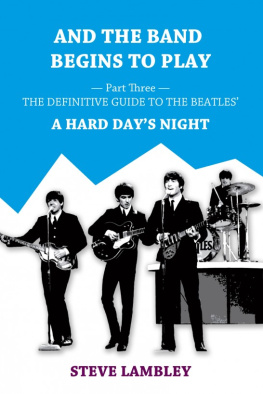
![Lambley - And the Band Begins to Play: [Part9 The Definitive Guide to the Beatles White Album]](/uploads/posts/book/213743/thumbs/lambley-and-the-band-begins-to-play-part9-the.jpg)
![Lambley - And the Band Begins to Play: [Part1 The Definitive Guide to the Beatles Please Please Me]](/uploads/posts/book/213741/thumbs/lambley-and-the-band-begins-to-play-part1-the.jpg)
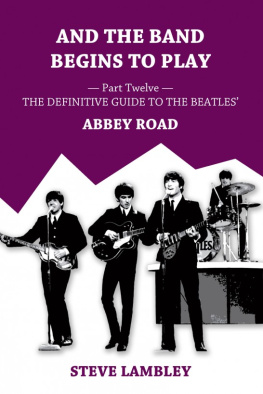


![Lambley - And the Band Begins to Play: [Part6 The Definitive Guide to the Beatles Rubber Soul]](/uploads/posts/book/213742/thumbs/lambley-and-the-band-begins-to-play-part6-the.jpg)
